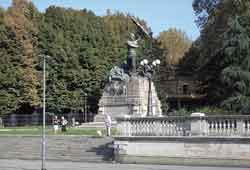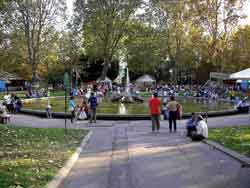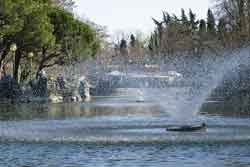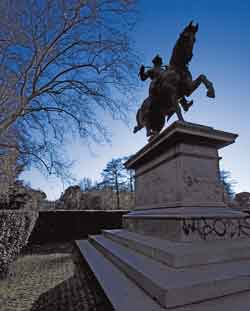How much it has seen! And how many roles it has played in
the unwinding of the history of the city through the
centuries!
Already, its beginning was the result of ancient events and
it could be said that it is the evidence of the indomitable spirit of
freedom of the Bolognese people, because the Montagnola is not a natural
hill (almost ten meters in altitude). It was gradually made by the
accumulation of rubble from the repeated destructions of the Rocca di
Galliera, rebuilt five times from the beginning of year 300 until 1511 as
a means of power of Papal Legate over the city, and each time brought down
by its citizens. 
The ruins of the Rocca di Galliera, "five times built against the
Bolognese freedom, five times brought down by its people" (Carducci),
raised from the year 500 and on from the earth of the excavations, the
high ground was raised on a flat land historically important in the life
of Bologna: the northern area of the ancient Campo Magno, which in the
year 200 was the very animated animal market (horses, cows, porks, etc.)
and was also called the Prato di Magone ("avere il magone" in the
Bolognese dialect means to have a lump in one's throat - Zanolini) because
this is where hangings of common delinquents took place.
In the year
600, the small rise was meant for the public passage of
carriages, becoming this way the city's first public garden: the slopes
were arranged, a wide road was built which ended in an octagonal large
square surrounded by elms and adorned, in 1757, with seven large stone
seats and numerous mulberry trees. The Montagnola began to be the
place for festivities, fireworks and, at the end of the 700s, even a few
corridas. In 1805, Napoleon ordered the creation, on the seven
hectares of the park, of a French-style promenade. Assigned to the
project, Giovanni Battista Martinetti realized "a lovely site
and
quite a bit raised” (this is how Ugo Foscolo had Jacopo Ortis describe it)
which little by little became also a place for the ascent of the hot-air
balloons of Marquis Francesco Zambeccari and his friends; for horse and
bicycle races; for military parades and magnificent carnivals.

In the
meantime, in the south area of the hill, the Giuoco del pallone or
Spheristerion was built in 1822, a project by Giuseppe Tubertini, and, in
the years 1893-96, on the side of Independence Street, the imposing flight
of steps, called the Pincio by the Bolognese, was built.
At the end of
the 800s, enriched with imposing sycamores, rows holm oaks, and paths of
lime-trees and fresh conifers, the Montagnola had also its café chantant
and, in the 900s, it was the venue for many important manifestations such
as the railway show Direttissima, the 1934 exhibition, the first editions
of the trade fair.
But, in July 1879, the Montagnola, a public city
park par excellence, was overwhelmed by the Regina Margherita promenade,
carried out at the foot of the hill and between Porta S. Stefano and Porta
Castiglione, over an area of 231,122 square meters that the city had
purchased from Count Angelo Tattini. An inscription, found in the actual
chalet, recalls that the project of the "promenade" was executed by
Ernesto Balbo Bertone, Count of Sambuy of Piemont, who "from ploughed land
created these gardens" designing a landscape of English inspiration later
called after Queen Margherita, spouse of Umberto I who had become king the
year before. At the centre of the park, a small lake was created using the
water from the Savena canal; it is bordered on the north side by selenite
rocks, and on the south side by picturesque bushes of vegetation, bridges
pass over the lake inhabited by an aquatic birdlife. Like the lake, the
large central lawn and the pathways, then in pebbles, are elements dating
back to its origins. Since then a permanent destination of the citizens of
Bologna of all ages and conditions, the Margherita Gardens have hosted

a
variety of events: in 1888, the Emiliana Exhibition (for which were built
elegant pavilions, such as those of Industry and Music, later dismantled)
made even more evocative and prestigious with the steam tramway that
brought visitors to San Michele in Bosco, There were also horse races,
festivities, concerts, shows, as well as political, cultural and sporting
events.
In this highly visited green area, there are also
testimonies of the more ancient history of Bologna: the reconstruction of
a Villanovan cottage created by the Archaeology Museum; two Etruscan tombs
in travertine from the necropolis discovered while the park was being
done; a strip of Roman road from Via Rizzoli and, on the south side of the
lake, a part of the ancient Savena canal, built in 1176. There was also,
for a number of years, a small zoo with fallow deers and goatlings that
had as their most natural king the much loved (by kids) lion Reno. At the
entrance of Porta Santo Stefano, dominated Vittorio Emanuele II who
during many years rode his horse in Piazza Maggiore.
If
Montagnola and the Margherita Gardens are among the greenest areas of the
city, essential to its growth, Bologna, at the beginning of the third
millennium can be proud of its more than a thousand hectares of public
parks. It also possesses an ancient and hidden wealth of private green
areas: numerous luxuriant gardens of its large palaces and small vegetable
gardens and courtyards of the modest homes of the historical centre.
But that is another evocative story of the turreted
city.